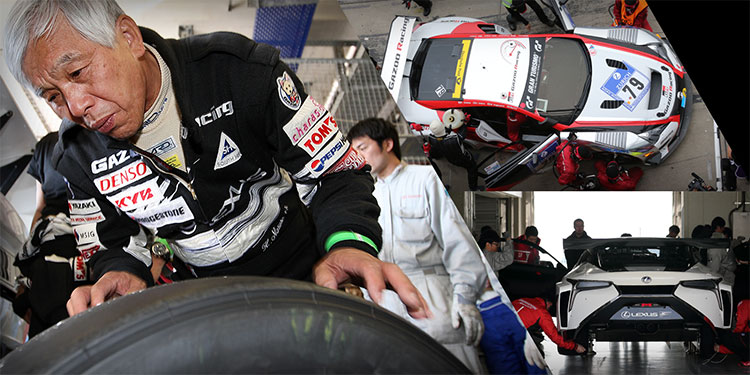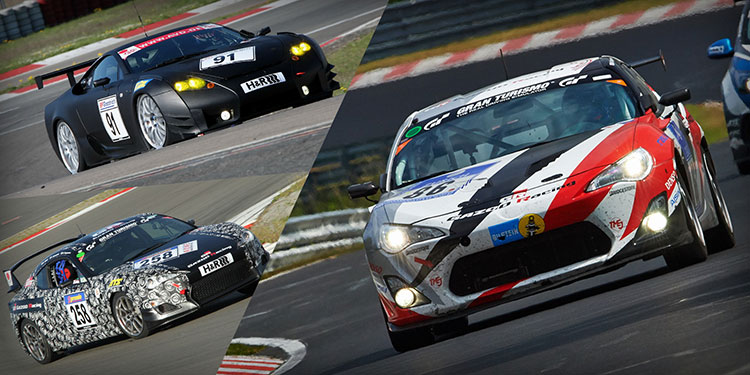The LFA, 86, and GR:
a process of evolution
In the 2008 edition of the 24 Hours of Nürburgring, a certain super car was entered. On the entry list, it said simply: “LF-A.” The vehicle, which had only been announced as a concept car a year earlier and was still under development, was suddenly scheduled to participate in the race.
Typically speaking, development of new cars takes place in secrecy; however, TOYOTA GAZOO Racing deliberately entered a car which was still under development into a race with exposure to huge audiences. The reason for this decision was to conduct extreme tests at the 24 Hours of Nürburgring and refine the car while fighting against rivals on living roads. TOYOTA GAZOO Racing recognized that identifying problems and points of improvement at the race, then feeding them back into the development of production cars, was a shortcut to making “ever-better” cars.
The company sought to run its cars at full speed on mountain passes with rough surfaces in a legal manner—this would have been impossible on a normal circuit, but the Nürburgring fitted the brief perfectly. If the car could compete in extreme conditions, while battling its rivals in the heat of a race, then the true qualities of the car—which would remain hidden on test courses or flat circuits—would be revealed by its finishing position.
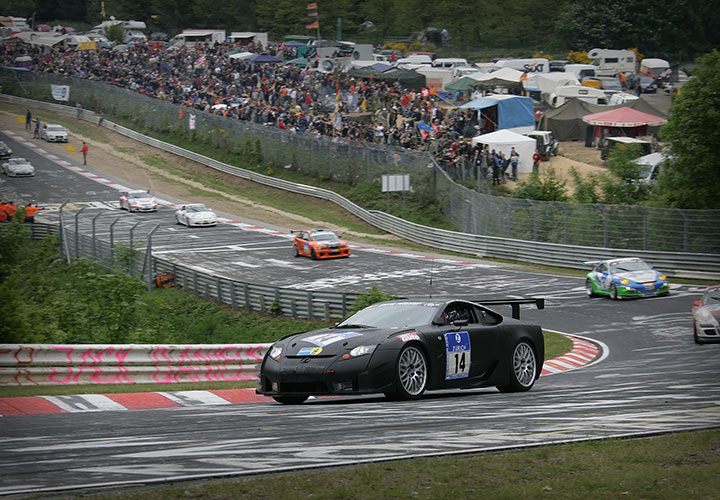
When problems occur in a race, they must be overcome in a limited timeframe. The team utilized all their knowledge to resolve issues—at times creating hand-made reinforcements while trackside—at a rate infinitely faster than required in the development of normal production cars, and witnessed the results of their efforts with their own eyes. Each team member identified solutions for making ever-better cars; the people who make the cars developed, and the car itself developed in turn.
Haruhiko Tanahashi, chief engineer for the LFA, commented: “When I drove the race car that had competed in the 24 Hours of Nürburgring, its steering felt clearly different to development cars I had driven up to then; upon analysis, the car’s bending rigidity was also different. This data was then fed back to other cars we had in development. This was something we would not have known if we had not entered the race—in other words, it is something that the race itself taught us.” In actual fact, after competing at the 24 Hours of Nürburgring, the performance of the LFA increased significantly.
The 2009 LF-A development vehicle utilized the experience and knowledge gained from participation at the Nürburgring to improve its aerodynamics and body rigidity.
The Toyota 86 is another sports car that was refined in a similar manner to the LFA at the 24 Hours of Nürburgring. It was officially unveiled in November at the Tokyo Motor Show 2011. Already in October, however, on the entry list for round nine of the VLN Endurance Championship Nürburgring—was the name of the Toyota 86 concept car: “FT-86.”
The FT-86 participated in the 2011 VLN. It was a prototype of the Toyota 86, a production car that was officially unveiled at the Tokyo Motor Show 2011.
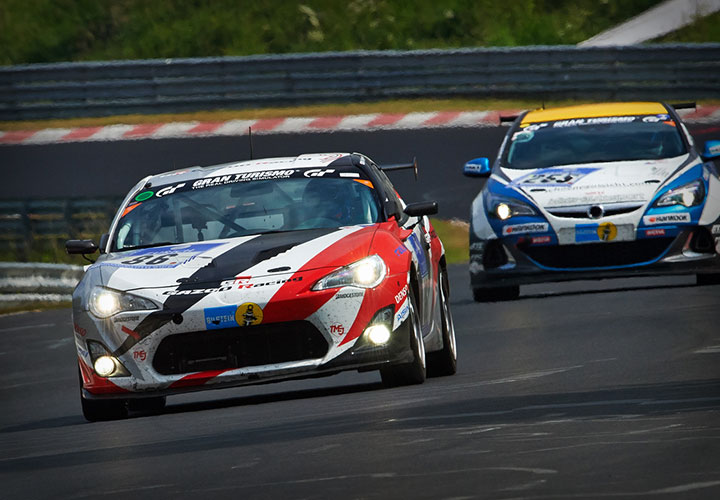
The 2014 version of the Toyota 86 was ideally balanced, and the team was confident it would win its class even if it only performed to 80 percent of its full potential.
The FT-86 was entered into the race so it could be driven in extreme conditions. The development car masked and sported a matt-black body color; however, modifications were minimal, with the only additions being the safety equipment required by race regulations. Consequently, the FT-86 that competed at the Nürburgring was almost unchanged from the base vehicle. While it completed the four-hour race trouble-free, the team identified issues that were preventing the Toyota 86 from becoming an even better car. The car was therefore refined via participation in the 24 Hours of Nürburgring from 2012 to 2014. This expertise was fed back into production car development, and led to the creation of the limited-edition 86 GRMN, the 86 Kouki—which was a partially redesigned version of the 86, and the 86 GR—this latter a model that was based on the 86 Kouki but incorporated 86 GRMN technologies.
Toyota again entered a pre-launch sports car into the 2018 edition of VLN9, the 9th round of the Nürburgring Endurance Series . The name on the start list was “Toyota A90”—a concept version of the GR Supra.
The A90 was entered for the same reason as the 86 had been some years earlier—so it could be tested in extreme conditions. The car was lightly camouflaged in an arabesque pattern featuring the TOYOTA GAZOO Racing theme colors of white, red, and black; it was also fitted with safety equipment and a minimum of other equipment required for racing. Otherwise, however, it was identical in specifications to the production car.
“Toyota again entered a pre-launch sports car into the 2018 edition of VLN9, the 9th round of the Nürburgring Endurance Series. The name on the start list was ‘Toyota A90.’”
The A90 completed the race incident-free, except for a grease leak from the drive shaft with approximately one hour of the race remaining. After the race, Morizo said to Chief Engineer Tetsuya Tada : “That was unbelievably enjoyable.” Tada was relieved. This comment was a sign that the Supra had passed its Nürburgring graduation exam.
The GR Supra made its world premiere at the 2019 North American International Auto Show in Detroit , before competing at the 24 Hours of Nürburgring later the same year. It secured third place in its class after an error-free 24 hours, thus marking a splendid comeback after 17 years.
One of the race drivers, Masahiro Sasaki, recorded his fastest lap during the night session. He reflected: “When I set my fastest lap, the circuit was not clear—I had to negotiate a number of back-markers. In fact, if you total up my fastest times for each sector, my time would have been under nine minutes. Since the GR Supra is essentially a production car with a few modifications, I was astounded at its raw performance.”
It is worth noting that while the LFA and 86 GRMN were limited-edition models, the GR Supra is a standard-edition model that can be purchased at any time. In other words, anyone can acquire the vehicle and experience the same thrill as a 24 Hours of Nürburgring race machine.
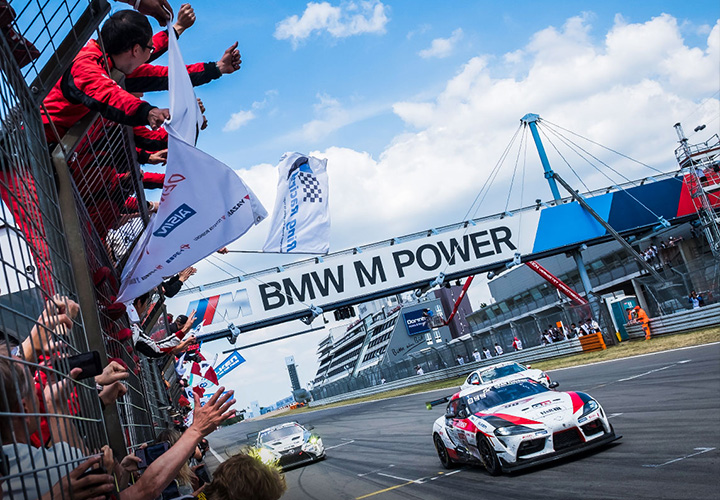
When it comes to what constitutes a “good car,” both racing cars and production cars share many of the same requirements. And this is not limited to the three race cars outlined above. Indeed, the members that make up GAZOO Racing’s Nürburgring team are normally engaged in the development of a variety of models. In other words, the knowledge and experience gained at the Nürburgring is transmitted indirectly to other Toyota cars as well.
Beginning in 2007, TOYOTA GAZOO Racing embarked on the challenge of refining its people and cars. Now, more than ten years later, its efforts have taken shape in the form of the GR. However, making ever-better cars is an unending process; seeking to develop even better cars, TOYOTA GAZOO Racing continues to participate at the Nürburgring.
